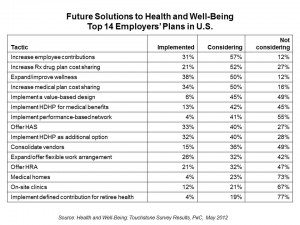
Health spending will increase by 7.5% in 2013, with employees’ contributions rising for in-network deductibles, prescription drugs and emergency room visits. 3 in 4 employers, seeking to control rising health expenses, will offer wellness programs, even though a vast majority can’t yet measure an ROI on them.
The Health and Well-Being: Touchstone Survey Results from PriceWaterhouseCoopers (PwC).
PwC points out that the 7.5% medical cost increase is historically lower than in recent years, as a result of structural changes in the health care market including:
- A sluggish economy
- Growing focus on cost containment
- Lower utilization of health services by patients
- Employers’ efforts to control spending.
Still, 7.5% is still several times greater than inflation. And with employees bearing greater proportions of health insurance premiums and service co-payments, increased medical spending could hit insured households harder in 2013 than in 2012. 50% of health plan enrollees have out-of-pocket maximums greater than $2,000, and 37% have coinsurance of 20% or more for most services in-network.
Wellness programs are a key tactic for employers looking to stem cost increases for health. 72% of employers offer wellness programs, the most common aspects being EAPs (84%), health risk appraisals (80%), biometric screening (71%), tobacco cessation (67%), and weight management (56%). Disease management programs are on the wane, dropping to 58% of employers offering them compared with 68% in 2010.
The chart shows the top tactics employers are adopting or considering to help manage health and wellness among employees. First under consideration is increasing employee contributions, followed by increasing prescription drug plan cost sharing, growing wellness programs, increasing medical cost-sharing (beyond pharma costs), implementing value-based benefit designs, and new health plan formats such as high-deductible health plans and health savings accounts. In addition, employers are looking to engage performance-based networks of providers.
Medical homes are being considered by 23% of employers, only 4% of whom currently offer medical home arrangements for workers. On-site clinics, another form of primary care, are currently offered by 12% of employers, with another 21% considering offering them to employees.
The survey was completed among 1,400 U.S. employers in the first quarter of 2012.
Health Populi’s Hot Points: PwC’s survey begs the question: will employers’ best attempts at extending wellness programs to workers help stem the rise of health costs? That is certainly the intention. Disease management has receded has a favored tactic for managing costs, although it is still being used by over one-half of U.S. companies PwC polled.
Thus far, employers say they can’t yet measure return-on-investment for wellness. Yet they take the leap of faith that wellness will be useful in the context that cost increases, while somewhat slowing down, still surpass the rate of general price inflation.
Kevin Volpp of the University Pennsylvania, and colleagues, offer a helpful perspective in this week’s
JAMA,
Assessing Value in Health Care Programs, to bolster employers’ confidence in extending wellness and other programs to improve population health. Volpp et. al. say that, asking about ROI is the wrong question when assessing whether a health care program is successful, arguing that few health care services actually directly save money. They consider a program that improves medication adherence after acute myocardial infarction (heart attack), recognizing that adherence rates to statins and beta-blockers following and AMI are quite poor. However, a successful program that reduces events requiring hospitalization 12 months follow a hospital discharge could be of value even though it might cost $3,000 by avoiding costs. The key in evaluating “value” vs. “ROI” is to develop relevant criteria to use in evaluating health care programs, thinking broadly and holistically. However, the way health care is financed and delivered in the U.S. often prevents this frame of thinking.
Employers looking at value-based benefit design are already on the road to thinking more broadly about total benefits and the opportunity to bolster whole health by looking at peoples’ whole lives. That broader mindset will help companies more effectively understand the total value of the wellness programs they provide.





 Thanks to Feedspot for naming this blog, Health Populi, as a
Thanks to Feedspot for naming this blog, Health Populi, as a